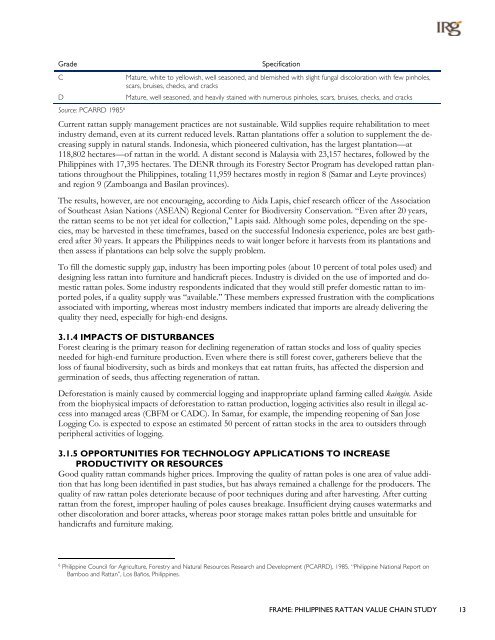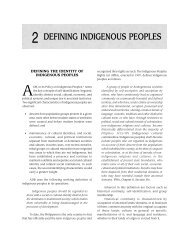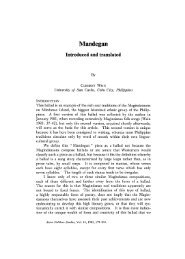PHILIPPINES RATTAN VALUE CHAIN STUDY - Aboutphilippines
PHILIPPINES RATTAN VALUE CHAIN STUDY - Aboutphilippines
PHILIPPINES RATTAN VALUE CHAIN STUDY - Aboutphilippines
Create successful ePaper yourself
Turn your PDF publications into a flip-book with our unique Google optimized e-Paper software.
GradeCDSource: PCARRD 1985 6SpecificationMature, white to yellowish, well seasoned, and blemished with slight fungal discoloration with few pinholes,scars, bruises, checks, and cracksMature, well seasoned, and heavily stained with numerous pinholes, scars, bruises, checks, and cracksCurrent rattan supply management practices are not sustainable. Wild supplies require rehabilitation to meetindustry demand, even at its current reduced levels. Rattan plantations offer a solution to supplement the decreasingsupply in natural stands. Indonesia, which pioneered cultivation, has the largest plantation—at118,802 hectares—of rattan in the world. A distant second is Malaysia with 23,157 hectares, followed by thePhilippines with 17,395 hectares. The DENR through its Forestry Sector Program has developed rattan plantationsthroughout the Philippines, totaling 11,959 hectares mostly in region 8 (Samar and Leyte provinces)and region 9 (Zamboanga and Basilan provinces).The results, however, are not encouraging, according to Aida Lapis, chief research officer of the Associationof Southeast Asian Nations (ASEAN) Regional Center for Biodiversity Conservation. “Even after 20 years,the rattan seems to be not yet ideal for collection,” Lapis said. Although some poles, depending on the species,may be harvested in these timeframes, based on the successful Indonesia experience, poles are best gatheredafter 30 years. It appears the Philippines needs to wait longer before it harvests from its plantations andthen assess if plantations can help solve the supply problem.To fill the domestic supply gap, industry has been importing poles (about 10 percent of total poles used) anddesigning less rattan into furniture and handicraft pieces. Industry is divided on the use of imported and domesticrattan poles. Some industry respondents indicated that they would still prefer domestic rattan to importedpoles, if a quality supply was “available.” These members expressed frustration with the complicationsassociated with importing, whereas most industry members indicated that imports are already delivering thequality they need, especially for high-end designs.3.1.4 IMPACTS OF DISTURBANCESForest clearing is the primary reason for declining regeneration of rattan stocks and loss of quality speciesneeded for high-end furniture production. Even where there is still forest cover, gatherers believe that theloss of faunal biodiversity, such as birds and monkeys that eat rattan fruits, has affected the dispersion andgermination of seeds, thus affecting regeneration of rattan.Deforestation is mainly caused by commercial logging and inappropriate upland farming called kaingin. Asidefrom the biophysical impacts of deforestation to rattan production, logging activities also result in illegal accessinto managed areas (CBFM or CADC). In Samar, for example, the impending reopening of San JoseLogging Co. is expected to expose an estimated 50 percent of rattan stocks in the area to outsiders throughperipheral activities of logging.3.1.5 OPPORTUNITIES FOR TECHNOLOGY APPLICATIONS TO INCREASEPRODUCTIVITY OR RESOURCESGood quality rattan commands higher prices. Improving the quality of rattan poles is one area of value additionthat has long been identified in past studies, but has always remained a challenge for the producers. Thequality of raw rattan poles deteriorate because of poor techniques during and after harvesting. After cuttingrattan from the forest, improper hauling of poles causes breakage. Insufficient drying causes watermarks andother discoloration and borer attacks, whereas poor storage makes rattan poles brittle and unsuitable forhandicrafts and furniture making.6Philippine Council for Agriculture, Forestry and Natural Resources Research and Development (PCARRD), 1985. “Philippine National Report onBamboo and Rattan”, Los Baños, Philippines.FRAME: <strong>PHILIPPINES</strong> <strong>RATTAN</strong> <strong>VALUE</strong> <strong>CHAIN</strong> <strong>STUDY</strong> 13
















